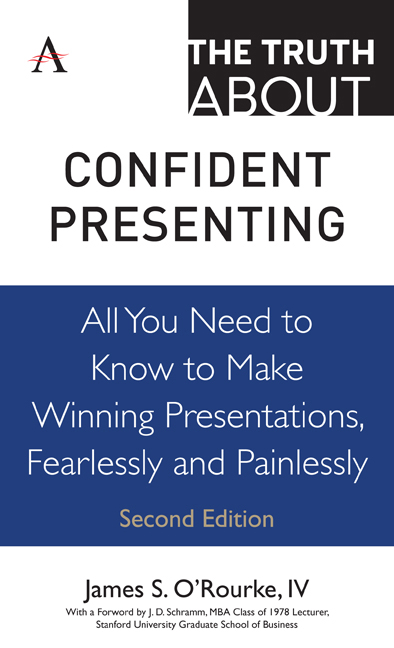 The Truth about Confident Presenting
The Truth about Confident Presenting Book contents
- Frontmatter
- Contents
- Foreword
- Introduction
- Part I Some Initial Truths
- Part II The Truth About Getting Ready to Speak
- Part III The Truth About What Makes People Listen
- Part IV The Truth About Developing Support for Your Presentation
- Part V The Truth About Getting Up to Speak
- Truth 25 Select a delivery approach
- Truth 26 Your introduction forms their first impression
- Truth 27 Begin with a purpose in mind
- Truth 28 Keep your audience interested
- Truth 29 Conclusions are as important as introductions
- Truth 30 Have confidence in your preparation
- Truth 31 Repeat the process as often as possible
- Part VI The Truth About Managing Anxiety
- Part VII The Truth About Nonverbal Communication
- Part VIII The Truth About Visual Aids
- Part IX The Truth About Handling an Audience
- Part X The Truth About What Makes a Presentation Work
- References
- Acknowledgments
- About the Author
Truth 31 - Repeat the process as often as possible
from Part V - The Truth About Getting Up to Speak
- Frontmatter
- Contents
- Foreword
- Introduction
- Part I Some Initial Truths
- Part II The Truth About Getting Ready to Speak
- Part III The Truth About What Makes People Listen
- Part IV The Truth About Developing Support for Your Presentation
- Part V The Truth About Getting Up to Speak
- Truth 25 Select a delivery approach
- Truth 26 Your introduction forms their first impression
- Truth 27 Begin with a purpose in mind
- Truth 28 Keep your audience interested
- Truth 29 Conclusions are as important as introductions
- Truth 30 Have confidence in your preparation
- Truth 31 Repeat the process as often as possible
- Part VI The Truth About Managing Anxiety
- Part VII The Truth About Nonverbal Communication
- Part VIII The Truth About Visual Aids
- Part IX The Truth About Handling an Audience
- Part X The Truth About What Makes a Presentation Work
- References
- Acknowledgments
- About the Author
Summary
No one gets to be a skilled or gifted public speaker by avoiding the experience. The best of speakers and presenters, in fact, are those who do it frequently and who enjoy it. It's never pleasant at first, of course, because you're still struggling with the basics of organization, evidence and delivery— not to mention adjusting to the audience, the occasion and the experience of being up there in front of all those people.
The truth about presenting, however, is that you'll get much better at it if you do it frequently. So, the advice here is simple: repeat the process as often as possible. Seek out opportunities to speak to your colleagues, friends, co-workers, clients, customers and others. Don't turn down an opportunity to give a presentation if your boss or friends should ask you to do just that.
Perhaps another lesson from behavioral psychology will help. It has long been known that behavior is affected by its consequences. We reward and punish people, for example, so that they will behave in ways that we consider desirable or appropriate. Edward L. Thorndike studied the effects of this consequence in a well-known experiment. He enclosed a cat in a box, but provided the possibility for escape, if the cat could figure out how the latch mechanism worked. The cat eventually moved the latch, which opened the door. When repeatedly enclosed in a box, the cat gradually stopped doing those things that had proven ineffective and eventually made the successful response very quickly.
Subsequent experiments by B. F. Skinner and others have shown that an animal's repeated success results in reinforcement of useful or desired behaviors, while unsuccessful (or painful) experiences will result in the extinction of behaviors that are neither useful nor productive. In essence, productive behaviors are reinforced, while negative or inconsequential behaviors are abandoned.
What do cats trying to escape from a box have to do with presenting? Well, humans react in much the same way as cats when confronted with stressful situations and each will exhibit behaviors that have 31 proven most useful or productive. If the speaker offers a pattern of organization that makes sense, or evidence that seems convincing, they reward the speaker with their attention, eye contact, engaged posture and more.
- Type
- Chapter
- Information
- The Truth about Confident PresentingAll You Need To Know To Make Winning Presentations, Fearlessly And Painlessly, pp. 123 - 126Publisher: Anthem PressPrint publication year: 2019


